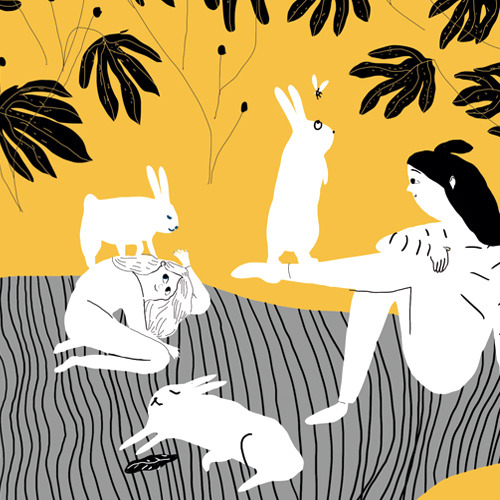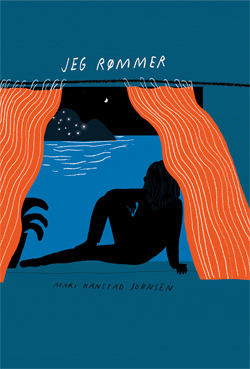< Back to posts
Mari Kanstad Johnsen
Norway

Mari Kanstad Johnsen was born in Bergen, a seaport in south-west Norway. She studied Visual Communication at Oslo National Academy of the Arts, then took a Master’s degree in Storytelling at Konstfack in Stockholm. Mari has written and illustrated many picturebooks, one of which received a Special Mention in the BolognaRagazzi Awards.
In this post, Mari talks about her wonderful wordless picturebook, ‘Jeg Rømmer’ (I’m out of here). This heartfelt story received a Special Mention in the Fiction category of the BolognaRagazzi Awards 2017. It’s published in Norway by Gyldendal Norsk Forlag.
Mari: ‘Jeg Rømmer / I’m out of here’ is about a girl who is torn from her roots and moves with her family to a house by the sea, where she starts at a new school. No one is really interested in getting to know the new girl.
The girl discovers an island through her binoculars at night, with something white and shiny moving around on it. She goes there in the middle of the night by boat, and finds a little paradise of friendly rabbits.
She takes one back with her, and shows it off at school, gaining her huge popularity. But when she sees the rabbit sitting in the window at night looking longingly towards his island and friends, she realises she has to take him back.
At school, she returns to unpopularity, but she finds more sustainable ways of surviving, starting to feel secure in her own company...
And in the end, she discovers a very small, slightly rabbity-looking girl in her class, and they develop a friendship.
The book is entirely without text.
I remember when my editor first asked me if I wanted to do a children’s book without text (Gyldendal Norsk Forlag, the publishing house, was planning to make a series of six wordless books). She wondered if it sounded intimidating or difficult to rely on images only.
When I write books, I usually start with the illustrations, spending a lot of time in the beginning just drawing and drawing without a clear direction, until some scenery or characters start to appear... Then I will usually keep drawing as a story appears in my head, and after a while I will start writing. Then I then go back and forth between drawing and writing.
So, I originally imagined using no text would cause me no troubles, almost making it easier, as I feel a lot more secure in my drawing than in my writing. But I soon realised I needed to make a whole lot of choices in the story to make it understandable through the images. Certain things can be explained so easily with just a couple of words, which become more complicated to explain through images.
On the other hand, having no words means the story can be read more freely, which is a bonus. For example, one of the scenes where the girl goes to the island with the rabbits appears a bit dreamy; it can be read as both real events or the girl’s fantasy. I like that it is up to the reader to decide. Also, the little girl who appears in the class at the end of the story is a bit mysterious. Maybe she’s a regular girl who has been there all along (but is so little she hasn’t been noticed before), or maybe she’s a sort of rabbit-like fantasy friend. I like these different readings. Growing up isn’t about one true story; everything depends on the point of view, and how a person experiences and understands something.
Here’s my very first attempt at the story. Simple digital drawings were done quite quickly and intuitively. It shows a lonely girl, on holiday with her family, who decides to swim off to an island to find out what is there.
I stuck with the core of the original storyboard, but took many detours while working out WHY the girl needed to run off, and what she would gain from it.
At an early stage, I tried to combine the story of this girl, which I already had a sense of, with a short graphic story I made on my Master’s degree about a mountain taking revenge on the industry quickly growing around it, polluting its air. The mountain lifts its masses of stone, like a skirt, and covers the city until it disappears, and slowly forest grows back. While trying to combine these stories, I thought that the girl protagonist, doing research, could figure out that a nearby volcano would be an extremely fruitful base to quickly grow plants that would take over the city again. The girl would be a secret hero in the end.
It turned out difficult to explain all her clever plans through images though, so the original story felt stronger to me.
I decided to focus on a theme which I often work with: Solitude and finding strength in yourself. Finding your own place instead of losing yourself to fit in.
Not using text, it worked for me to focus only on one person and their connection with animals, which makes the lack of dialogue natural.
Also, this wordless universe is a nice way to communicate certain dynamics that are difficult to explain in words. The girl is not bullied by anyone at her new school; the other students, who become a bit of a blended mass, are just busy with their own stuff. No one is particularly interested in making a new friend.The story became more and more clear while I was drawing, and the images in the final book are in many ways very typical of how I work – with different techniques and expressions. This is seldom a conscious plan. It’s more that with some images, I have a clear idea what they should be, maybe strong and colourful graphic images that I work towards with determination, while with others, I like the original sketches the best, and stay with the simple pencil drawing.
But in contrast to other children’s books I have made, this one is more influenced by comic books, using several frames per page to explain the story more clearly.
During the making process it acquired even more frames, but I did some strict editing and simplifications in the end because I wanted more single images occupying a whole page, drawing the reader into the emotions of the story.
Some images were drawn in one go – pencil drawings that were digitally coloured afterwords...
And some images were put together in bits and pieces – little details on different sheets.
While going through all the sketches and originals for the book in preparation to write this post, I remembered many detours in the plot I had completely forgotten...
For example, on one of the originals used for a final image, all the girls in the new school have tiny, fancy dogs on their desk. I had an idea that the girl would sit up all night sewing a dog suit for the kidnapped rabbit, bringing it to school pretending it was a cool little dog. But it was just too complicated and didn’t work visually. Also, on one original, the rabbit is switched with a monkey. This was simply because the previous book I illustrated (‘Tunellen’ published by Magikon Forlag) was about two rabbits, and I thought maybe I shouldn’t only make books about rabbits... But rabbits felt like the right thing for this story, so I returned to the rabbits.
And so many other things. It often feels random how books I make turn out in the end; there are so many small choices along the way, but there is always this basic feeling that I keep all the way, like with this book: A feeling of not belonging, looking for an outside solution, but sticking with your thing.
Illustrations © Mari Kanstad Johnsen.
Jeg Rømmer /
I’m out of here
Mari Kanstad Johnsen
Gyldendal Norsk Forlag, Norway, 2016
‘This wordless picturebook tells the story of a lonely girl who moves house and school and needs to find a way of making friends. She finds a special rabbit, which she uses to help her make new friends – a clever device, although she soon discovers that she can be a good friend without anything special to help her. The pace of the pictures, and hence the story, varies interestingly – sometimes fast, sometimes more reflective. A very personal book, it makes its point with gentle humour.’
—The BolognaRagazzi Award Jury





















